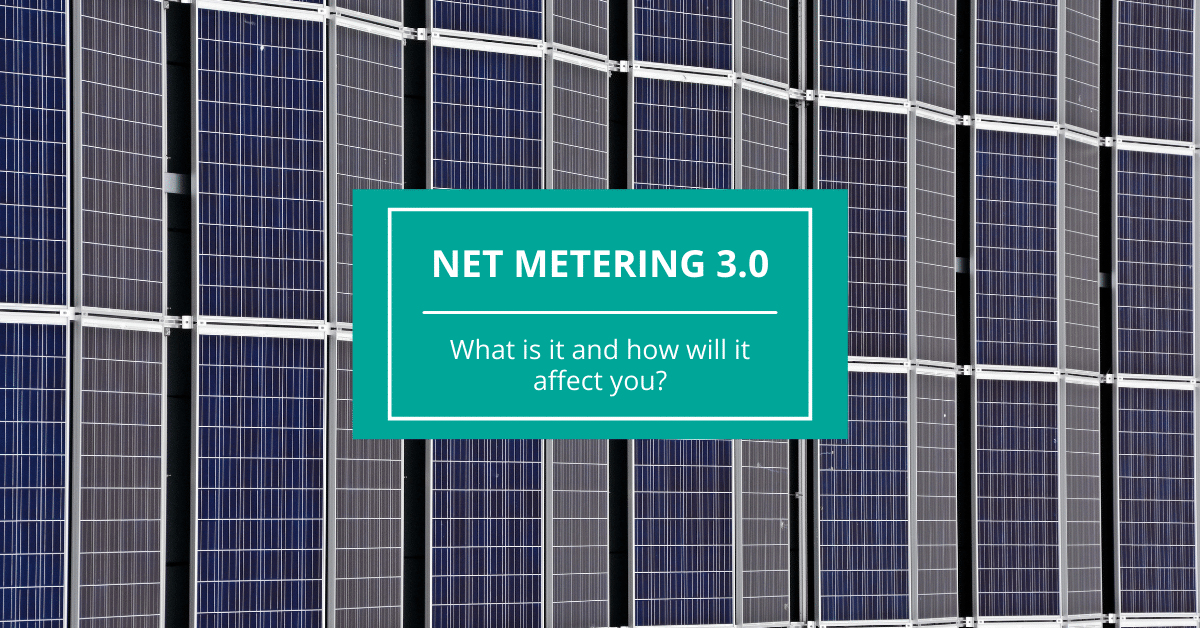The state of California has long been a national leader in solar energy. A large part of this was due to its early adoption of a net metering policy, the policy that allows homeowners with solar panels to earn credits for the excess energy that they create and send back to the utility grid.
However, the California net metering policy has evolved over time and is in the midst of yet another evolution. Currently, California residents are governed by Net Metering 2.0; however, the California Public Utilities commission (CPUC) is currently in the process of creating Net Metering 3.0, which is expected to potentially significantly change the way that net metering works.
What Did Net Metering 2.0 Change?
Before looking into the crystal ball and attempting to determine how Net Metering 3.0 may affect customers, it is important to get a sense of the past history. You’ve likely concluded that Net Metering 2.0, the current law, was not the original and you’d be right. In fact, California was initially governed by Net Metering 1.0 (as you would assume).
However, the first policy set a cap on the amount of people that could take part as 5% of an electric company’s customers. By 2016, this cap was near being reached, which led to the creation of Net Metering 2.0. California’s three major utility companies switched to 2.0 between 2016 and 2017 with San Diego Gas & Electric the first and Southern California Edison the last.
Net Metering 2.0 actually did not change a lot; however, consumers do feel as if it did because some of the changes were financial in nature. Specifically, it added in something known as non-bypassable charges. These are charges of a few cents per kilowatt hour paid by customers to help subsidize programs that provide utility assistance for the poor among other things. Under Net Metering 2.0, when customers sell their excess power back to the grid, these charges are subtracted.
However, despite this change, Net Metering 2.0 is still a very beneficial policy for homeowners with solar. The main staple of the bill is that people with solar power receive credits at the retail rate. Many other states cut the credit received down to the wholesale rate or a fraction of the retail rate. This means California has one of the better policies in the nation for customers.
How is Net Metering 3.0 Being Developed?
As noted, the CPUC is currently hard at work attempting to structure Net Metering 3.0. The formal proceeding can be viewed here. The proceeding has been ongoing since gall 2020 and is expected to take some time in order to ensure that stakeholders are effectively able to provide input.
This process originated with something called the Net Metering 2.0 Lookback Study. This 300-plus page document serves as the basis for discussions on Net Metering 3.0. Its primary finding can be found in the opening paragraph where it was noted that participants in Net Metering 2.0 saw substantial benefits while normal ratepayers saw increased costs for utilities.
As the Net Metering 3.0 process moves forward, input will be collected from residents and utility companies. The major part of the process will occur later in the year when potential successor policies are outlined, which could occur as early as late spring. Proposals will be submitted by a variety of entities. These include California’s three major utility companies, advocates for solar power, and advocates for normal utility customers. From these proposals, an eventual policy will arise.
When Will Net Metering 2.0 Expire?
As you may imagine, the answer to this question is currently unclear. It would depend on how long it takes for a new policy to be created. However, given the fact that Net Metering 3.0 was originally expected to be created in 2019 only to be delayed by forest fires, a PG&E bankruptcy, and the coronavirus, it is safe to assume there is pressure to get it done quickly.
When attempting to sort the tea leaves, it would appear likely that a new policy will come into play as early as the fall of this year. This means that Net Metering 3.0 could be reality sooner rather than later.What Will Net Metering 3.0 Entail?
This is the million dollar question that will significantly detail what California’s solar market will look like for years to come. While specifics clearly are not yet known, ideas can be inferred from prior information.
First, a common theme in the energy community of late has been the perception that Net Metering 2.0 essentially serves as a cost shifting policy. The argument made is that solar panel owners receive full credits (minus non-bypassable charges) while relying on the grid to transport the energy they sell without paying any share of the upkeep cost of the grid.
This particular argument is a bit flawed as studies have shown that solar power through net metering contributes more to the market than the benefits solar panel owners receive. However, it is a popular argument that has gained significant traction. Thus, it is likely that Net Metering 3.0 will see a reduction in compensation for solar panel owners. The question at hand is what the reduction would look like.
During the writing of Net Metering 2.0, utility companies advocated for changes such as reducing payments to just above wholesale cost, adding fixed monthly charges to solar customers, and charging a grid access fee based on system size. These all failed but will likely come up again this year. While all these changes are unlikely to happen, it would not be surprising to see some reduction in payments from the retail rate or the imposition of a fee.How Does This Affect Me?
If you are currently a customer operating under Net Metering 2.0, the good news is that you will be grandfathered into that agreement for 20 years from the date of your solar installation. So you will not be affected by Net Metering 3.0 until then.
For homeowners who have not yet invested in solar panels but are considering it, the crystal ball suggests that Net Metering 3.0 will be less economically beneficial than the current policy. Thus, you may want to make the leap and invest in solar to take advantage of the 20-year grandfathering. Getting solar panels installed prior to November of this year will lock you into Net Metering 2.0 for these 20 valuable years.


